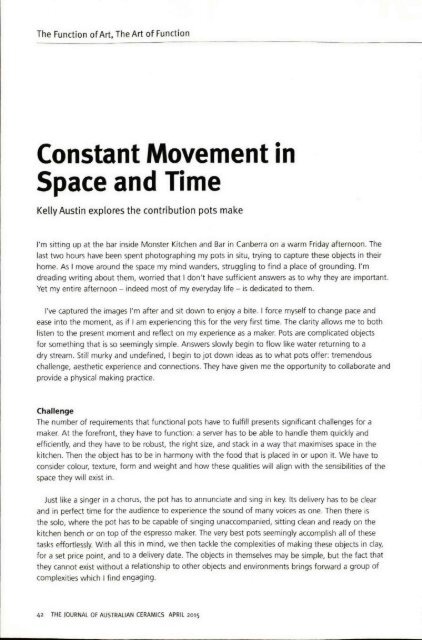The Journal of Australian Ceramics Vol 54 No 1 April 2015
You also want an ePaper? Increase the reach of your titles
YUMPU automatically turns print PDFs into web optimized ePapers that Google loves.
<strong>The</strong> Function <strong>of</strong> Art, <strong>The</strong> Art <strong>of</strong> Function<br />
Constant Movement in<br />
Space and Time<br />
Kelly Austin explores the contri bution pots make<br />
I'm sitting up at the bar inside Monster Kitchen and Bar in Canberra on a warm Friday afternoon. <strong>The</strong><br />
last two hours have been spent photographing my pots in situ, trying to capture these objects in their<br />
home. As I move around the space my mind wanders, struggling to find a place <strong>of</strong> grounding. I'm<br />
dreading writing about them, worried that I don't have sufficient answers as to why they are important.<br />
Yet my entire afternoon - indeed most <strong>of</strong> my everyday life - is dedicated to them.<br />
I've captured the images I'm after and sit down to enjoy a bite. I force myself to change pace and<br />
ease into the moment, as if I am experiencing this for the very first time. <strong>The</strong> clarity allows me to both<br />
listen to the present moment and reflect on my experience as a maker. Pots are complicated objects<br />
for something that is so seemingly simple. Answers slowly begin to flow like water returning to a<br />
dry stream. Still murky and undefined, I begin to jot down ideas as to what pots <strong>of</strong>fer: tremendous<br />
challenge, aesthetic experience and connections. <strong>The</strong>y have given me the opportunity to collaborate and<br />
provide a physical making practice.<br />
Challenge<br />
<strong>The</strong> number <strong>of</strong> requirements that functional pots have to fulfill presents significant challenges for a<br />
maker. At the forefront, they have to function: a server has to be able to handle them quickly and<br />
efficiently, and they have to be robust, the right size, and stack in a way that maximises space in the<br />
kitchen. <strong>The</strong>n the object has to be in harmony with the food that is placed in or upon it. We have to<br />
consider colour, texture, form and weight and how these qualities will align with the sensibilities <strong>of</strong> the<br />
space they will exist in.<br />
Just like a singer in a chorus, the pot has to annunciate and sing in key. Its delivery has to be clear<br />
and in perfect time for the audience to experience the sou nd <strong>of</strong> many voices as one. <strong>The</strong>n there is<br />
the solo, where the pot has to be capable <strong>of</strong> singing unaccompanied, sitting clean and ready on the<br />
kitchen bench or on top <strong>of</strong> the espresso maker. <strong>The</strong> very best pots seemingly accomplish all <strong>of</strong> these<br />
tasks effortlessly. W ith all this in mind, we then tackle the complexities <strong>of</strong> making these objects in clay,<br />
for a set price point, and to a delivery date. <strong>The</strong> objects in themselves may be simple, but the fact that<br />
they cannot exist without a relationship to other objects and environments brings forward a group <strong>of</strong><br />
complexities which I find engaging.<br />
42 THE JOURNAL OF AUSTRALIAN CERAMICS APRil <strong>2015</strong>

















